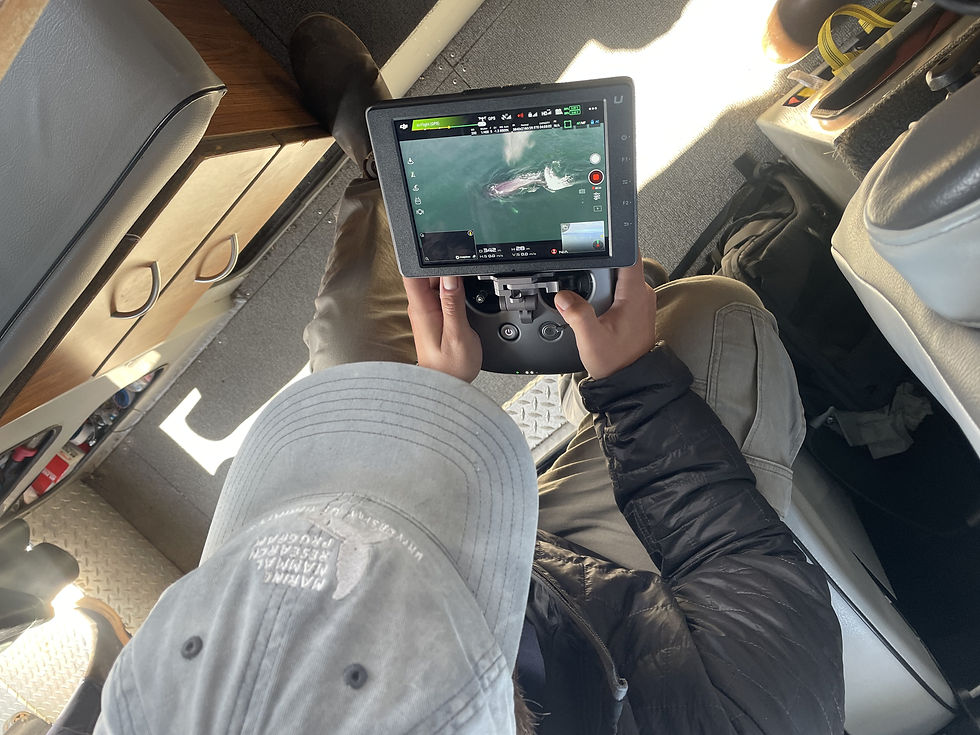AWF Research Update: June, 2023
- AWF Team

- Jul 12, 2023
- 3 min read

Month at a Glance
Effort:
Days on the water = 10
Sampling stations = 96
Total # Photo-IDs = 157
Drone Flights = 90
Biopsies = 5
Nutrient Samples = 88
CTD Casts = 96
Whale Poop Samples = 1
Whale numbers:
Number of unique whales = 142
Number of cow-calf pairs = 7
Bubble-netting groups = 5
Number of unique bubble-netters = 72

Above: Distribution of humpback whales photo-identified during June 2023. Size of red circles reflects group size (smallest circle = 1, largest = >16 whales). Triangles represent locations of surveyed “Point Count” stations for estimating whale abundance; these provide an indication of where photo-identification efforts were conducted (and, due to weather, were not).

Above: Average chlorophyll concentration (mg/m^3) in the top 20 m of the water column, measured at survey stations in June.
Research Overview
Despite some opportunistic data collecting in May, June marked the official first month of field work for the 2023 summer field season. As is often the case during the early season, weather and equipment "bugs", together with a few mild Covid infections, kept the AWF field team from getting out on the water as often as they would have liked. However, the team was still able to survey 96 of 108 survey stations in nine days between June 2nd to June 22nd.
Overall, the number of whales observed in the study region was low, though not so low for this time of year to cause concern. Of the 142 individual whales observed, eleven are new to the AWF database and seven were calves. 78% of the whales observed could be linked through citizen science-based records in happywhale.com to one or more breeding grounds. Approximately 87% of those whales have been observed in Hawaii, with 9% observed in Mexico and 4% observed in both Hawaii and Mexico across multiple years. The field team made 89 drone flights and collected 150 whale body condition images, though some whales might have been sampled more than once. Whales tended to be scattered, with loose, presumably krill-feeding, aggregations mainly in Frederick Sound. Two groups of cooperative foraging “bubble-netters” were found in North Chatham. As in past years, Tebenkof Bay continues to be a whale hotspot in June, with at least three groups of bubble-netters (though, membership within these groups changed often as individuals joined and left) and dozens of solitary whales feeding on abundant herring that could be seen ‘boiling’ at the surface.

Above: AWF graduate fellow Dana Bloch collecting a whale poop sample.
About AWF's Field Work:
Each month from June through September, the AWF team visits up to 108 survey stations that are evenly distributed throughout the study region. At each station, the team conducts a 15min 'point count' and records the location of every whale they observed. At the same time, they deploy probes that measure ocean salinity, temperature and chlorophyll concentrations - the latter a proxy for phytoplankton biomass - from the surface to a depth of ~50m. They also collect water samples to measure nutrient concentrations. These data provide a detailed picture of the water column’s physical and chemical structure throughout the study region.
After completing the point count, the team then travels to each whale they observed to collect photo-identification images, launch Unoccupied Aerial Systems (“drones”) to measure the body volume of individual whales, and collect biopsy samples to measure hormone concentrations, stable isotope ratios (for reconstructing diet) and examine genetic profiles. Once all these data have been collected, the team travels to the next station and repeats the process. It takes a minimum of 9 days to complete each survey; however, it can take far longer if weather and whales are uncooperative.
About AWF Research Reports
AWF aims to bridge the gap between scientists, stakeholders, and the public by communicating our general research findings through publicly available reports and information brochures. These reports provide up-to-date information on the status of Southeast Alaska humpback whales and are intended to serve as resources for local communities, stakeholders, policymakers, and educators.
Stay tuned for monthly reports during our field season from June-September, as well as an annual research report released every fall. You can also sign up for our newsletter below and visit this page to support AWF's research financially.



Top off your style with the legendary Rips Hat. Go full Yellowstone with Rip Wheeler Outfit.